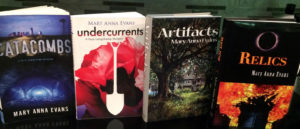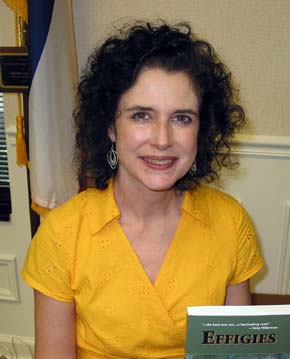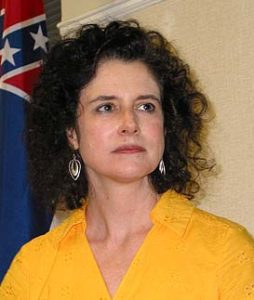Major Works
- Wrecked (coming in October 2020)
- Catacombs (2019) Book 12
- Undercurrents (2018) Book 11
- Burials (2017) Book 10
- Isolation, 2015 Book 9
- Rituals: A Faye Longchamp Mystery (2013) Book 8
- Plunder: A Faye Longchamp Mystery (2012) Book 7
- Strangers (2010) Book 6
- Wounded Earth: An Environmental Thriller (2010)
- Floodgates (July 2008) Book 5
- Findings (May 2008) Book 4
- Effigies (2007) Book 3
- Relics (2005) Book 2
- Artifacts (2003) plus numerous short stories, Faye Longchamp series, Book 1
- and several non-fiction books
Biography of Mary Anna Evans (2003)
Mary Anna Evans was born on December 2, 1961, in Hattiesburg, Mississippi, to Irvin and Lillian Sellers. Many of her happiest memories in her childhood days were spent reading books. A few of Evans’s favorite authors include Jane Austen, Robert Heinlen, Laura Ingalls.. She wrote her first short story in a high school creative writing class. In an email interview (the student author wishes to remain anonymous), Evans said, “I remember being excited and confused by what the teacher wrote on my paper. I was very excited about the A+ (obviously), but confused by her comment that she was curious about why I chose to write science fiction. I was concerned that if she couldn’t tell the difference between science fiction and fantasy, then maybe her A+ wasn’t worth all that much!” Evans managed to maintain an impressive 4.0 grade point average throughout all of her high school career at Lamar County High School in Mississippi She was a Mississippi Junior Miss beauty queen for Lamar County (Langley). Evans also plays a grand piano.
After high school, Evans went on to college where she obtained a Bachelor of Science in Engineering Physics degree from Murray State University. She then got a Master of Science in Chemical Engineering from the University of Mississippi (Ole Miss) in 1984. (Her master’s thesis was entitled A Modeling Study of the NH3-NO-O2 Reaction Under the Operating Conditions of a Fluidized Bed Combustor!) On her personal web page, Evans says, “I’m … a chemical engineer by training and license, with a degree in engineering physics thrown in for spice.” Evans continued her studies and received a Master of Fine Arts from Rutgers University in 2015 . “”I just tend to be interested in a lot of things,” said Evans in a phone interview with an SHS student. Evans is now a university professor at Gaylord College of the University of Oklahoma. She teaches fiction writing, nonfiction writing, creative writing pedagogy, and math and science literacy.
Evans has previously worked as an environmental consultant, an offshore roustabout, an university administrator, a community college instructor, gift wrapper, and bank teller. She has three children. After the birth of her third child, Evans left her job as an environmental consultant to focus on her family and begin her writing career.
Evans resided in Florida for some time, so her first novel, Artifacts, is set on a small island off the coast of Florida. Her second novel, Relics, is a sequel to Artifacts. Set in east Alabama, Faye Longchamp is called to lead her first professional archaeological project since finally earning her degree. She is part of a team investigating the history of a mysterious group of mixed-race people called the Sujosa who have lived in the area for centuries. Shortly after her team arrives, people start to die.
Mary Anna Evans next published Effigies, Findings,and Floodgates (set in New Orleans after Katrina). Effigies was a Book Sense Notable Book. Evans has also published Strangers in 2011, Plunder in 2012,and Rituals in 2013. All eight are Faye Longchamp archaeological mysteries. In 2010, Evans also published a thriller called Wounded Earth. Her short stories are available in her collection, Jewel Box. She has also published non-fiction books dealing with writing and math literacy. (Note: There are now twelve books in the Faye Longchamp series.) A thirteenth novel entitled Wrecked is coming out in the fall of 2020.
Evans’s novels have received recognition including the Mississippi Author Award, and the Florida Historical Society’s Patrick D. Smith Florida Literature Award, the Benjamin Franklin Award, and three Florida Book Awards Bronze Medals, and just recently the Oklahoma Book Award for Catacombs, which is set in Oklahoma, where she now lives. She’s also had a spot on Voice of Young America’s list of “Adult Mysteries with Young Adult Appeal.” Her works have been on the Independent Mystery Booksellers Association’s (IMBA) bestseller list and have been designated Notable Books by Booksense and IndieBound.
Evans is currently (2020) teaching at Gaylord College at the University of Oklahoma. She is a licensed chemical engineer as well as the writer of archeaological thrillers.
Interview with Evans, December 8, 2003
by SHS student
1. Where and when were you born in Mississippi?
I was born in Hattiesburg, Mississippi, on December 2, 1961.
2. What are your parents’ names?
My parents were Irvin and Lillian Sellers.
3. Do you recall any of your childhood memories from high school, college, etc. ?
Many of my happiest moments in childhood and afterward were spent reading books, which is why it is such a thrill to think about other people reading my own books.
4. When did you know that you wanted to become a writer? Was there something in particular that inspired you or got you interested in writing?
I’ve always enjoyed writing stories and poems. I wrote my first short story in a high school creative writing class. I remember being excited and confused by what the teacher wrote on my paper. I was very excited about the A+ (obviously), but confused by her comment that she was “curious about why I chose to write science fiction.” I was concerned that if she couldn’t tell the difference between science fiction and fantasy, then maybe her A+ wasn’t worth all that much!
5. How difficult was it to get your first book published? How did you go about it?
Getting a book published is a long process. For me, it first involved writing a novel that earned the interest of a very good agent but that, unfortunately, has never been published. Then I wrote Artifacts, which Poisoned Pen Press purchased last year.
6. Did you base any of the characters in the book Artifacts on people you know or knew?
I almost never base characters on real people–I don’t want to hurt the feelings of people I like, and I don’t want to suffer lawsuits inflicted by people I don’t like! I do, however, occasionally give characters the first name of someone I know whose name suits the character, but I always make sure that the character is completely different from the person whose name I “borrowed.” People seem to like seeing their names on the page. (Look, everybody, I’m on page 138!)
7. Who is/are your favorite author/authors?
Wow, tough question. I enjoy Jane Austen, Robert Heinlein, Laura Ingalls Wilder, F. Scott Fitzgerald, and whoever I’m reading at the moment.
8. What author/authors do you think has influenced you and your writing the most?
All of the authors I listed above have influenced me in some way, but only one of them–James Lee Burke–is considered a mystery writer, so here are a few people that write within my genre that I admire: James Lee Burke, Nevada Barr, and P.D. James.
9. Why did you decide to write about archeology as a tool to uncover clues in Artifacts and how long did it take you to write Artifacts? Where did you get the idea for Artifacts and how much research was required?
The first germ of an idea for Artifacts grew out of my desire to write a book set in a dilapidated antebellum plantation house. I asked myself what kind of story needed such a setting–after all, Gone With the Wind had already been done and, besides, it is a story of its times. Audiences loved Gone With the Wind in the 1930s, but what would twenty-first century audiences love?
I decided that this house would be owned by a woman descended both from the masters who lived in the house and the slaves that built it. How would she feel about the house? And how would she feel about herself, about her very own heritage? These felt like questions that could support a book.
It seemed likely that this woman, Faye, would not have inherited money with the house, but she would have a different kind of wealth in the form of the artifacts her ancestors left behind. When I imagined her digging up these artifacts and selling them to earn the money she needed to save the house, I knew that she was archaeologist. And when I thought about what it meant to dig on an island that has been inhabited for thousands of years, I knew that she was destined to dig up a body, sooner or later. I wondered what would happen if she found a body that wasn’t old enough to be an archaeological find–a murder victim–and it was only then that I knew I was writing a mystery.
And, yes, research is a big part of writing a book like Artifacts. It probably took me a year and a half to do the research and write the manuscript.
10. What kind of student were you in high school?
I was one of those boring 4.0 students.
11. Are you currently working on a new book? If so, what is it called and when will it be published? Do you have a title for it yet? What is it about?
I’m currently working on a sequel to Artifacts, called Relics. It should be out in August of 2004. It is set in east Alabama, where Faye has been called to lead her first professional archaeological project since finally earning her degree. She will be part of a team investigating the history of a mysterious group of mixed-race people called the Sujosa who have lived in the area for centuries, but short after her team arrives, people start to die…
12. Besides writing, what else do you enjoy doing in your spare time?
I lead my church’s youth choir, and my husband (she is now divorced from him) and I perform music occasionally. I also enjoy reading and needlework and yoga and, of course, spending time with my three kids.
13. How has Mississippi or living in Mississippi influenced your writing?
I read recently that southern fiction is defined by its emphasis on the family and by the importance of its setting, which functions almost as an extra character. I think that our families–both the kin that we know and the kin who lived long before we ever graced the earth–live on in our values and our actions and in our DNA. And the places where we have lived, and where our families have lived, are also integral parts of our beings. These things make us who we are, and Faye’s heritage in the form of her family and her home permeates my book. People from other parts of the country can and do write wonderful books every day, but it took a Mississippi girl to write this particular one.
14. Do you have any advise for future writers?
Read a lot of different stuff. Write a lot of different stuff. Spend a lot of time writing stuff that is just for you, so that you can flex your creative muscles without worrying about what someone else might want to buy. Then, when you feel ready to get rejected for a few years, find a good teacher and let them help you get publication-ready.
15. Do you have any advise for students today?
Don’t forget that education has other purposes besides simply becoming qualified for gainful employment. (Although gainful employment is nice. I recommend it.) Try to find things that interest you, then learn all you can about those things. Interested people are interesting people.
16. Are you planning continuing any of the characters in Artifacts in future novels? (Note: Interview date was 2003).
Yes. My next novel, Relics (Note: Relics was published in 2005), will feature some of the same characters, and I have a couple more adventures for Faye up my sleeve.
Related Websites
Bibliography
- Evans, Mary Anna. “About Mary Anna.” http://www.maryannaevans.com
- Evans, Mary Anna. Artifacts. Scottsdale: Poisoned Pen Press, 2003. Jacket cover.
- Evans, Mary Anna. E-mail interview with SHS Student (Anonymous). December 8, 2003.
- Langley, Greg. “What People Are Saying About Artifacts.” http://www.maryannaevans.com


